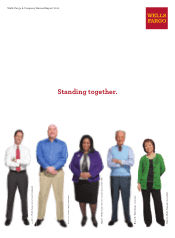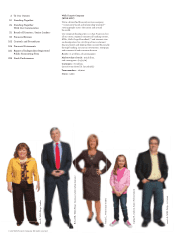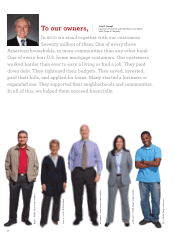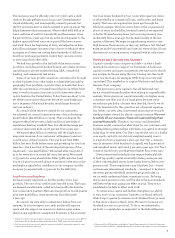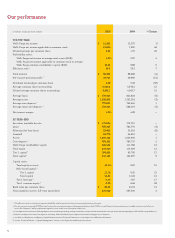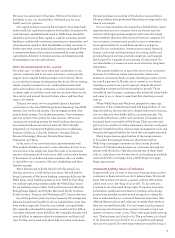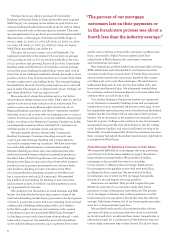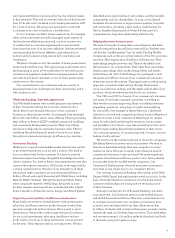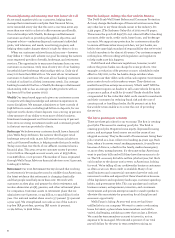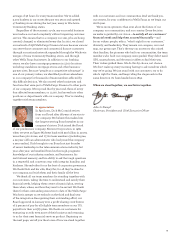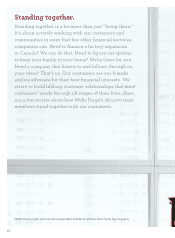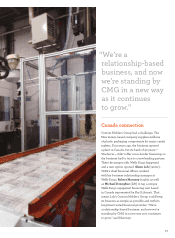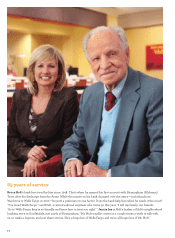Wells Fargo 2010 Annual Report Download - page 7
Download and view the complete annual report
Please find page 7 of the 2010 Wells Fargo annual report below. You can navigate through the pages in the report by either clicking on the pages listed below, or by using the keyword search tool below to find specific information within the annual report.
We await its assessment of that plan. We know the value of
dividends to you, our shareholders. We thank you for your
loyalty and yourpatience.
Our capital position is among the strongest of any large bank
in the world, but capital isn’t meant to be hoarded, it’s meant to be
used. Strongly capitalized banks such as WellsFargo should be
allowed to put more of their capital to work for economic growth,
lending to creditworthy customers, investing in communities, and
returning more capital to their shareholders so they can invest it.
At the same time, our #1 financial goal remains unchanged: Have
a conservative financial structure as measured by asset quality,
capital levels, diversity of revenue sources, and dispersing risk
by geography, loan size, andindustry.
How’s the merger going? So far, so great
Two years ago—to oer more value and convenience to our
current customers and to our new customers—we began the
largest, most complex banking merger in U.S. history. We’re
now in the final innings of integrating Wachovia. We’re creating
single computer systems for our combined businesses that
serve all 70million of our customers, so their hometown bank
is always right around the corner and we can serve them across
the country and around the world when, where, and how they
want to beserved.
The past two years, we’ve completed almost a hundred
conversions to the One WellsFargo brand. Amazing! One ATM
system. One credit card system. One mortgage system. One
mutual funds system. One brokerage system. One retirement
services system. One system for trust services. We’re now
creating one operating system for retail banking, the nation’s
most extensive financial services network. We’ve already
integrated our Community Banking operations in Alabama,
Arizona, California, Colorado, Delaware, Georgia, Illinois,
Kansas, Mississippi, Missouri, Nevada, New Jersey,
Tennessee, and Texas.
So far, each of our conversions has gone extremely well.
That might look like a miracle to some observers, but not to us.
Our success so far simply has been the result of an immense
amount of planning, hard work, focus, skill, and sacrifice by tens
of thousands of our dedicated team members who are visible
or invisible to our customers. We can’t thank them and their
familiesenough.
We’re determined to finish the job with the same focus
that has served us so well the last two years. We still need to
bring 70percent of Wachovia banking customers fully into the
WellsFargo retail banking system in 2011. We’ll do that when
we combine operating systems under the WellsFargo brand
for our banking stores in NewYork and Connecticut (March),
Pennsylvania (April), and Florida, Maryland, North Carolina,
South Carolina, Virginia, and Washington D.C. later intheyear.
In just the past two years, by every measure, this merger has
delivered significant benefit for all our stakeholders, more than
even we first expected. One plus one, indeed, can equal three.
We originally estimated the integration would cost $7.9billion.
Our latest estimate: about $6billion. We originally thought we’d
save $5 billion in expenses after the integration and that’s still
true. To date, we’ve used only about half our initial write-down
through purchase accounting of Wachovia’s loan portfolios.
Those portfolios have performed better than we expected at the
time of our merger.
For our team members, the merger has doubled their career
opportunities across a company twice our former size, the
nation’s 12th-largest private employer with more U.S.-based
team members than any other financial services company. For
our customers, it means more products, more convenience,
more opportunities for sound financial advice and price-
value. For our communities, it means more capital: financial,
human, and social, and the presence of a strong, stable, and
growing financial services provider, employer, and taxpayer
(7th-largest U.S. taxpayer in 2010 among all industries). For
our shareholders, it means an even more attractive, long-term
investment.
The merger enables us to earn even more of our customers’
business. In California, where we’re now the state’s most
extensive community bank, we grew checking accounts in 2010
by a net 8.2percent. In Florida, yet to convert to our brand,
checking accounts rose a net 10percent, despite the state’s
struggling economy and slower population growth. That’s
virtually all new business, customers who either left other banks
and came to us, or chose to open their first checking account
withus.
When WellsFargo and Wachovia merged two years ago,
customers of the combined new bank had $745.4billion of core
deposits with us. At year-end 2010, despite the recent recession,
our core deposits were $798.2billion, up seven percent. Our
two million Wachovia credit card customers (consumer and
business) have converted to WellsFargo. They can view and
print up to 24 months of online statements, choose to end paper
delivery, benefit from free online money management tools, and
be protected against liability for fraud that’s promptlyreported.
Many huge revenue opportunities of the merger remain
to be seized. For example, there are about three million
WellsFargo mortgage customers in the 15 states plus the
District of Columbia who became our customers through our
merger with Wachovia. Only about 29percent of them bank
with us. Only about one of every five of our banking households
nationwide with a mortgage, have a Wells Fargo mortgage.
Hugeopportunity!
Community Banking: Cross-sell milestone
If anyone tells you it’s easy to earn more business from current
customers in financial services, don’t believe them. We should
know. We’ve been at it almost a quarter century. We’ve been
called, true or not, the “king of cross-sell.” To succeed at it,
you have to do a thousand things right. It requires long-term
persistence, significant investment in systems and training,
proper team member incentives and recognition, taking the
time to understand your customers’ financial objectives, then
oering them products and solutions to satisfy their needs so
they can succeed financially. You can’t expect much progress
in earning more business from current customers in just one
quarter or even in a year or two. That’s why many banks give up
on it. The bad news is it’s hard to do. The good news is it’s hard
to do, because once you build it, it’s a competitive advantage
that can’t be copied. If it were easy, everyone would be doingit.

